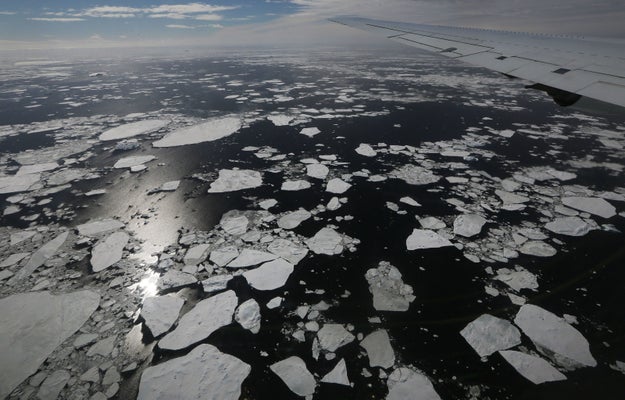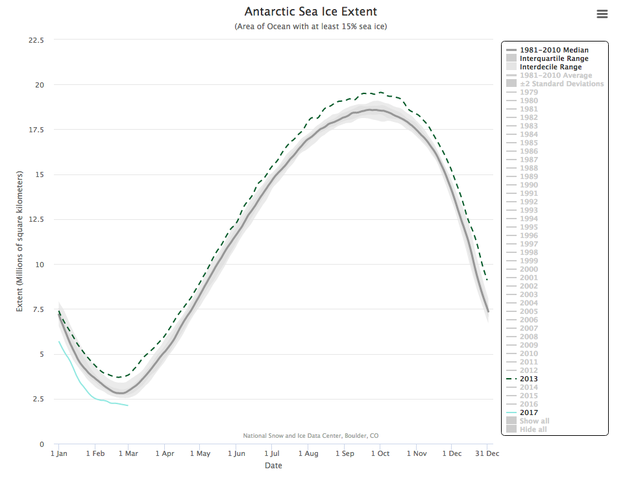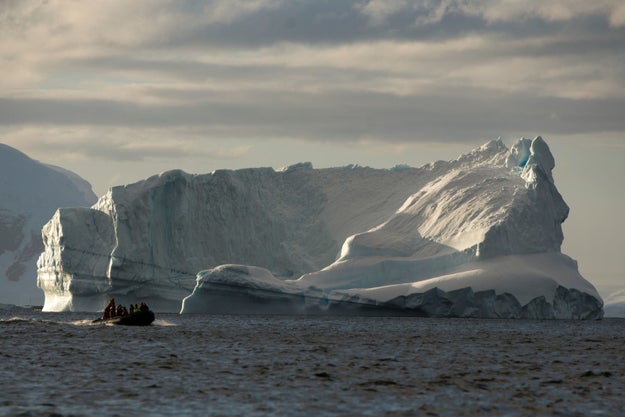[ad_1]

Sea ice floating near the coast of West Antarctica as seen from a window of a NASA airplane in October.
Mario Tama / Getty Images
In 38 years of satellite observations, climate scientists have never seen so little sea ice surrounding Antarctica as they do right now.
Only about 818,000 square miles of the ocean around Antarctica was frozen over with sea ice on March 1, according to data analyzed and published by the National Snow and Ice Data Center (NSIDC).
Not only is that a record low of this time of year, but it is an all-time minimum for any day in the history of satellite observation of sea ice there.
Because summer still has a few more weeks left in the Southern Hemisphere, that sea ice could shrink even more.
“We have still not bottomed out,” Mark Serreze, director of NSIDC, told BuzzFeed News. “This minimum could occur any day now. But it will definitely be a record.”

The history of sea ice extent in the Antarctic, with the light blue line representing ice in 2017.
NSIDC / Via nsidc.org
An added bit of drama for Antarctica comes over the fate of the Larsen C Ice Shelf, a Delaware-sized slab of glacial ice rifting away from the Antarctic Peninsula. The 70 mile rift is more than a third of a mile deep and more than 300 feet wide.
Glaciologists have given the ice shelf weeks to months to calve, creating a massive iceberg. Its collapse will not raise sea levels, as the shelf is already floating. The 2002 collapse of the related Larsen B shelf played out over six weeks.
Over the past several months, the Arctic Ocean on the opposite side of the world has also seen record-low sea ice — a new nadir in a decades-long decline that, climate scientists say, is one of the many fingerprints of humans' hand in warming Earth's atmosphere and oceans through the burning of fossil fuels.
But the influence of the release of heat-trapping gases is much less clear with sea ice around the South Pole. The overall extent of Antarctic sea ice has bucked the predictions of climate models, which say frozen continent's sea ice should be shrinking. In reality, the trend since 1979 has been one of slight, if highly variable, increase.
That variability is born out by the fact that only three years ago, in 2014, Antarctic sea ice set a record high.
The extent of Antarctic sea ice appears to be more sensitive to seasonal weather rather than long-term warming, as is the case in the Arctic.
“Unlike the Arctic, most sea ice around Antarctica is first-year ice,” Zachary Labe, a Ph.D. student in climate science at the University of California, Irvine, “meaning most of it melts during the warm season and then reforms during the cold/freeze season.”
Winds, for example, play a larger role in determining Antarctic sea ice extent, not only by bringing in warm air to melt ice but, more importantly, by jostling the ice loose, exposing more of the unfrozen ocean.

Tourists cruise close to icebergs in the western Antarctic peninsula.
Eitan Abramovich / AFP / Getty Images
A natural climate pattern seemingly unrelated to human activity, called the Interdecadal Pacific Oscillation, may have helped the Antarctic keep sea ice for longer than computer simulations of human-induced warming would suggest, Serreze said.
That oscillation refers to the sloshing of warmth from the northern Pacific Ocean to the southern Pacific, and back, over a cycle that takes anywhere from 15 to 30 years. Colder conditions in the ocean's southern waters have encouraged sea ice growth.
“It's a bit of a puzzle here,” Serreze said. “We're trying to catch up with this.”
The question now for climate scientists is determining whether this new record low is the beginning of the effect of man-made climate change finally swaying of Antarctic sea ice.
“We're still not quite sure,” Serreze said.
LINK: There Is A Searing Scientific Debate About Missing Arctic Ice
LINK: Disappearing Arctic Sea Ice Loss Will Help Russia Export Its Oil
[ad_2]
